What does true adventure look like? Do you crave miles of golden sands beneath a vast, azure
sky, ancient rock formations, and the thrill of discovering hidden oases in one of the world’s
most legendary deserts? This is the Gobi Desert road trip itinerary from Ulaanbaatar to the
Gobi, and back that promises a profound connection with nature. Pack your spirit of adventure
and set off on a road trip with SIXT (find our cars here).
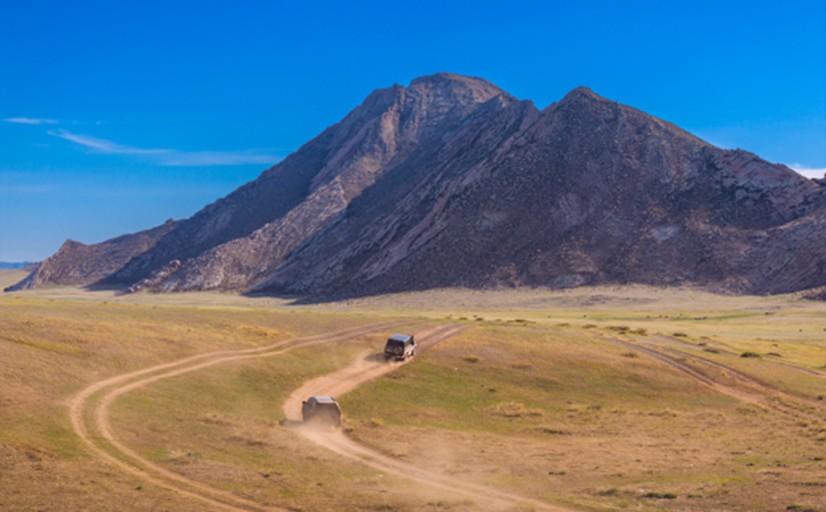
Tour to Gobi Itinerary Overview
Our road trip starts and ends in Ulaanbaatar, taking you through some of the Gobi Desert’s most
iconic locations, including Khustai Nuruu National Park with its wild horses, the highest Sand
Dunes in the Gobi, and various other noteworthy stops. The route forms a loop, ensuring you
experience diverse landscapes and attractions without retracing your steps.
Map and Route Details:
- Start/End: Ulaanbaatar
- Key Stops: Ulaanbaatar, Ulaanshiveet, Kharkhorin, Bat-Ölzii, Khujirt, Arvaikheer, Bulgan, Sevrei, Dalanzadgad, Ulaanbaatar.
- Route Type: Loop
Distance and Duration:
- Total Distance: Approximately 1,600 kilometers
- Suggested Duration: 10 to 14 days
This itinerary is designed to give you ample time to explore each location, with the flexibility to
linger in places that capture your interest, making it ideal for adventurers who appreciate both
structure and spontaneity
Vehicle and Gear Recommendations
For such a diverse and rugged landscape, choosing the right vehicle is crucial. The Toyota Land
Cruiser 76 and Toyota Prado are recommended for their reliability and comfort over varied
terrain.

Optional Extras for a Comfortable Travelling Mongolia

- Camping Set: For those nights under the stars, a camping set, available at SIXT offers
- convenience and comfort.
- Roof Top Tent: Available upon request, this addition from SIXT Mongolia makes it easy
- to set up camp anywhere along your journey.
- Vehicle Protections: Opt for the Loss Damage Waiver, Gravel Protection, Sand and
- Ash Protection, Tire and Windscreen Protection, and Road Side Protection. These
- options, offered by SIXT Mongolia, provide peace of mind allowing you to fully enjoy your
- adventure without worry.
Ulaanbaatar – Modern Capital of this Fascinating Country
Ulaanbaatar is not only the political and economic center of the country but also the cultural
heart. Begin your journey at Sukhbaatar Square, a major city landmark, where you can soak in
Mongolia’s history, surrounded by significant buildings such as the Parliament House and the
National Academic Theatre of Opera and Ballet of Mongolia. The square often hosts events and
festivals showcasing Mongolian culture through music, dance, and traditional sports. Close by in
walking distance is the Choijin Lama Temple, an interesting and historic temple in the city
center. The Shangri-La Mall and many restaurants are around the temple.

The SIXT rent a car station located on the main square in the Bluesky Hotel.
The National Museum of Mongolia is a must-visit. This museum presents a broad sweep of
Mongolian history, from prehistoric times to the socialist era. It is renowned for its extensive
collection of ethnic costumes, musical instruments, and even dinosaur fossils.
For something unique, the International Intellectual Museum offers a quirky look at Mongolian
puzzle traditions and the inventive spirit of the Mongolian people. It features challenging puzzles
and traditional games like the Shatar, the Mongolian version of chess.
As for accommodations, Ulaanbaatar offers a range of options, from modern hotels to guest
houses, providing an authentic Mongolian experience. The Shangri La Hotel stands out with its
five-star rating, offering an ideal blend of luxury and local charm, positioned near key business
and cultural areas. Another top choice is the Blue Sky Hotel & Tower which is known for its
spectacular city views from the rooftop bar and restaurant. The Best Western Premier Tuushin
Hotel and Novotel Hotel also offers luxury with modern, spacious rooms featuring floor-to-ceiling
windows, centrally located near government and cultural sites.
Khustai Nuruu National Park – Sanctuary of the
Przewalski’s Horses
A nice destination for the first road trip day leaving Ulaanbaatar is the Khustai Nuruu National
Park in the west of the town. The national park is renowned for the reintroduction site of the
Przewalski’s horse, also known as Takhi. This species, once extinct in the wild, now thrives
within the park. The park spans over 50,000 hectares and boasts a variety of habitats, including
red deer, wolves, and numerous bird species like the saker falcon and golden eagle.

Experience many activities available at the park. Wildlife watching is a highlight, with the park
being a sanctuary for Przewalski’s horse and other wildlife, such as the Mongolian gazelle and
lynx. The park is also a significant birding destination with over 223 recorded bird species,
making it an ideal spot for birdwatching. Hiking is another popular activity, with trails that
showcase the park’s scenic landscapes and rich biodiversity.
The Khustain Nuruu National Park is home to numerous archaeological sites within its
boundaries. These include ancient tombs and gravesites that provide insights into the region’s
historical inhabitants.
The Khustai Ger Camp offers traditional Mongolian accommodations within the park itself. This
camp is equipped with gers (Mongolian yurts) that feature amenities such as single beds,
electric lights, and tea and coffee-making facilities.
Camping is not allowed inside the National Park but can be done between the main road and
the Khustai park, for example in the sand dunes or on one of the hills on the side.
Elsen Taserkhai Sand Dunes – A Slice of the Gobi
Continue your trip towards west to explore the first “Gobi” along your Mongolia tour. The
inclusion of Elsen Tasarkhai in your Gobi Desert road trip itinerary enriches your travel
experience with its unique ecosystem and cultural offerings. Elsen Tasarkhai is a unique area of
Mongolia, often referred to as the “Mini Gobi.” This stunning location offers an 80 km stretch of
beautiful sand dunes that lie across the provinces of Tuv, Bulgan, and Uvurkhangai. The
landscape around Elsen Tasarkhai is diverse, blending the semi-arid desert with grasslands and
mountain areas rich in flora and fauna.
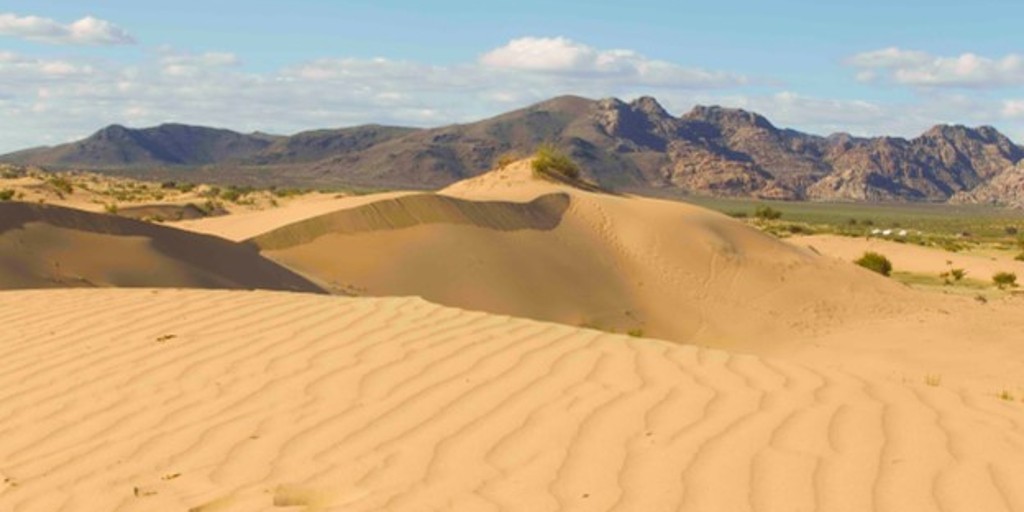
One of the key activities at Elsen Tasarkhai is camel riding. This activity allows you to
experience the desert in a traditional and immersive way. Exploring the sand dunes, whether on
foot or by camel, offers a chance to enjoy the serene beauty of the desert landscape and
capture stunning photographs of the golden sands.
We recommend you stay in a traditional Mongolian Ger (yurt). These camps provide an
authentic experience of Mongolian culture and hospitality, set against the backdrop of the
picturesque dunes.

There are several accommodation options available to enhance your experience of this unique
desert landscape. Traditional Ger Camps are the most authentic choice, with several facilities
such as Elsen Tasarkhai Ger Camp, Khugnu Khan Ger Camp, Bayan Gobi Lodge and Erdene
Ukhaa Ger Camp offering stays in Mongolian gers (yurts), complete with local meals and
cultural activities. Elsen Taserkhai also offers many stunning camping spots. We recommend
driving a kilometer up North on the Eastern Side of the dunes from the high way. Avoid driving
into the sand
Kharkhorin – Ancient Capital & Authentic Mongolian
Culture
You next stop is the home of Chinggis Khaan and the capital of the Mongol Empire. Kharkhorin
offers rich history, culture, and natural beauty, which makes it a must-stop location for your road
trip to the Gobi Desert.

Here, you can explore Mongolia’s rich past at the Erdene Zuu Monastery, one of the oldest
Buddhist monasteries in the country, surrounded by 108 stupas and housing priceless religious
artifacts. The Museum of Kharkhorin offers a deep dive into the city’s historical significance with
its extensive collection of archaeological finds.

Kharkhorin is located in the stunning Orkhon Valley, a UNESCO World Heritage Site known for
its picturesque landscapes. As you explore this expansive valley, you can take in the sights of
the majestic Orkhon Waterfall, hike through lush meadows, or ride horses along the rolling hills.
For accommodations, consider staying at local ger camps like the Sweet Gobi Eco Lodge,
Munkh Tenger Ger Camp, or Dream Gobi Lodge, which offer a taste of traditional Mongolian
living. The Ikh Khorum Hotel offers a high level of comfort in the center of the town. Camping is
best south of Kharkhorin on the edge of the Orkhon valley. Activities in the valley include visiting
the Tuvkhun Monastery, set in scenic surroundings, and interacting with nomadic families to get
a glimpse of their enduring traditions. Whether you’re hiking, horseback riding, or simply soaking
in the panoramic views, Orkhon Valley offers a perfect mix of adventure and tranquillity.
Ongii Monastery – Remnants of Buddhist Heritage
From the green steppes of Central Mongolia this suggested tour is taking a turn now going
south to the Great Gobi desert. On the way you will find the Ongii Monastery, which is a
significant historical site on your Gobi desert road trip, representing the remnants of a
once-vibrant Buddhist monastic complex. Originally built in 1660, it was one of Mongolia’s
largest monasteries before its destruction in 1939 during communist purges. Today, the site
consists of haunting ruins that stretch across both banks of the Ongi River, providing a poignant
reminder of Mongolia’s religious history.
While exploring the Ongii Monastery ruins, experience the remains of numerous temples and
university buildings. The site also offers opportunities for quiet contemplation and photography.
The surrounding area’s tranquility makes it a perfect spot for meditation or simply enjoying the
serene environment.
You can choose from a range of accommodations including traditional yurt campsites like the
Secret of Ongi Camp, offering authentic Mongolian gers with desert views. Budget-friendly
options such as the Gobi Erdene Ger Camp and Oasis Guesthouse are also available, providing
basic amenities and a cultural experience.
Travel advice: The drive from Central Mongolia to Ongii can be regarded as challenging as
most of this part has to be driven on unpaved roads. Prepare your navigation in advance (you
can request navigation assistance before your trip from SIXT – please contact the SIXT branch)
and start the drive early in the morning.
Flaming Cliffs Bayanzag – Dinosaur Legacies
Next stop are the Flaming Cliffs, but don’t worry you won’t get burned! Flaming Cliffs at
Bayanzag is a must-visit place on your road trip to the Gobi Desert. The cliffs, with their fiery red
hues particularly striking at sunset, are a must-visit for photography enthusiasts looking to
capture the unique landscapes of the Gobi.
When visiting the Flaming Cliffs, the best times for photography and fossil hunting are at sunrise
and sunset, when the light accentuates the vivid colors of the cliffs. While here, you can engage
in short, scenic walks around the area, which offer a close-up view of the striking geological
formations and any exposed fossils. For accommodations, there are several ger camps located
on the surrounding plains, providing a serene and authentic stay in the Mongolian steppe.
Eco-friendly options like Gobi Nuur Eco-Ger Camp utilize sustainable practices such as solar
power.
For a more luxurious stay, the Three Camel Lodge provides upscale amenities and cultural tours
in a scenic desert setting.
Dalanzadgad – The Heart of South Gobi
After a couple days of pure nature you might be missing the city life. Dalanzadgad is the capital
city of the Gobi. It has the charm of a frontier town, located in the center of the great Gobi
desert. Before venturing out again into the vast Gobi Desert, many travelers stop here briefly to
stock up at the local supermarket.
The town of Dalanzadgad has a new museum filled with less-than-perfectly preserved wildlife
and timeworn exhibits. However, for those intrigued by relics of the past, it offers a curious peek
into history.
After a day of exploration, checkin one of the city’s hotels or drive to a ger camp close to Yolin
Am. Hotels in the city are the Khan Uul Hotel, Khanbogd Tourist Camp, Goviin Bayanburd – Gobi
Oasis Camp.
Gobi Gurvan Saikhan National Park
Gobi Gurvan Saikhan National Park, or the Three Beauties of Gobi, is just a short distance from
Dalanzadgad. The park, which spans an impressive 27,000 square kilometers, holds the title of
Mongolia’s largest national park. Initially established in 1965 to protect the stunning landscapes
of the Yol Valley and its surrounding mountains, the park has since expanded to include areas
like the Khongor Sand Dunes, the paleontological sites at Khermen Tsav, and the Zulganai River.
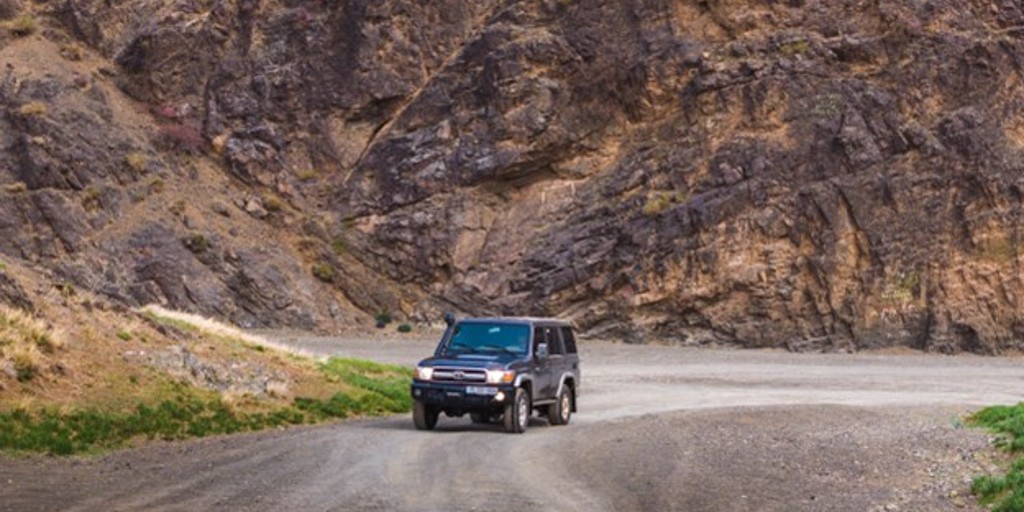
Accommodations near Yolin Am are the Gobi Mirage is a family-run ger camp that provides
traditional yurt accommodations with en suite bathrooms and is known for its hospitality and
beautiful sunsets or the Dungenee Camp.
Yolin Am – The Ice-Filled Valleys of the Gobi
Yolyn Am, a magnificent gorge in Gobi Gurvansaikhan National Park, has been protected since
1965 and became part of the national park in 1993. Located 56 kilometers from Umnugovi’s
central town, the valley is framed by the towering Eastern Beauty mountain massifs, a Paleozoic
gabbro formation.

The towering rock walls, narrow canyons, and the stark contrast of the desert landscape make
every view picturesque. Be on the lookout for the diverse wildlife, including the elusive snow
leopard, ibex, and the regal eagles for which the valley is named. As you trek through the gorge,
the landscape unfolds dramatically with towering rock walls and narrow canyons set against the
desert backdrop.

Accommodations range from traditional ger camps offering yurts with amenities like hot showers
and electricity, to luxury lodges such as the Gobi Nomad Lodge, which provides deluxe gers
with en-suite bathrooms and air conditioning for a comfortable yet authentic experience
Khongor Sand Dunes – The Singing Sands
The Khongor Sand Dunes, also known as the Singing Dunes, are a stunning highlight of
Mongolia’s Gobi Desert. These extensive dunes, some reaching up to 300 meters in height,
stretch over an area that makes them one of the most impressive in Mongolia. Known for the
mysterious, melodious sounds they produce, which are caused by the shifting sands, the dunes
offer a truly unique experience.

You can do many activities here, from adventurous sandboarding and sledging down steep
dune slopes to more serene camel rides across the desert. The climb to the top of the dunes is
a must-do; it takes about 30 minutes to an hour and rewards climbers with breathtaking
panoramic views, especially striking at sunset.
The dunes are surrounded by communities of nomadic herders. This provides a fantastic
opportunity to learn about the traditional Mongolian nomadic lifestyle, including their unique
methods of dairy production and camel herding.
Accommodations near the Khongor Sand Dunes in the Gobi Desert offer a unique stay in the
dramatic landscapes of Mongolia. Visitors can choose from several ger camps that provide easy
access to the dunes and surrounding attractions. Notable options include the ‘Juulchin Khongor’,
‘Gobi Erdene’, ‘Gobi Discovery’, and ‘Goviin Anar’ camps, which are known for their traditional
Mongolian gers (yurts) and modern amenities such as showers—essential for washing off sand
after a day of exploring the dunes.
White Stupa Tsaagan Suvarga – The White Marvel
White Stupa, known locally as Tsagaan Suvarga, is a striking natural formation in the Dundgobi
province, characterized by its cliff that stretches about 400 meters long and rises between 30 to
60 meters high. The cliffs are notable for their bright, layered colors—shades of orange, purple,
and red—that make them a photogenic spot, especially at sunset. These colors, visible due to
the sedimentary makeup of the cliffs, often give them the appearance of ancient ruins from a
distance.
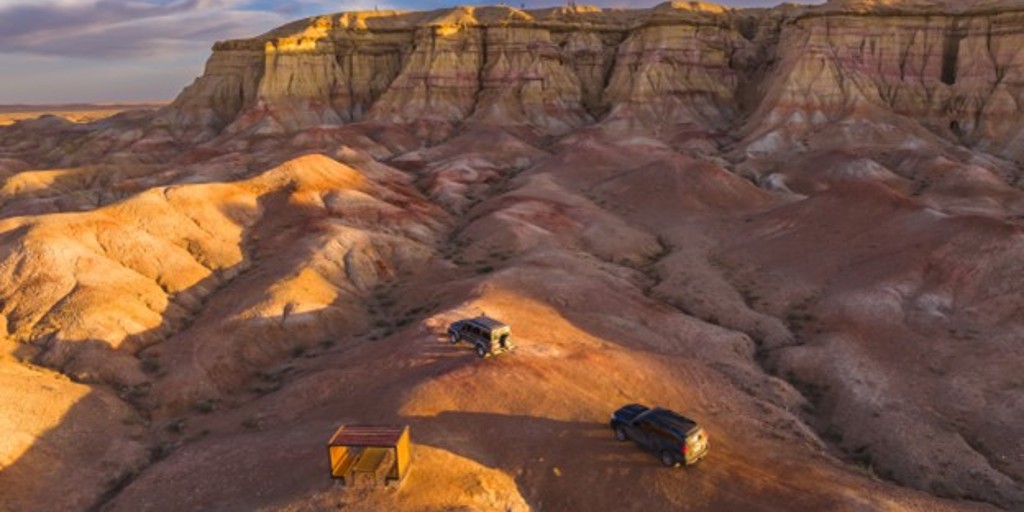
The area is popular for hiking, where you can explore the expansive views and unique
geological features on your tour of the Gobi Desert. It’s also a great spot for photography, with
the vibrant cliff faces and vast landscapes offering a dramatic backdrop, especially during the
golden hours of sunrise and sunset
Accommodations near White Stupa Tsaagan Suvarga include several options. Gobi
Caravanserai located 10 minutes drive offers various types of rooms with facilities including
electricity and water. The camp also serves buffet dinners on specific days and emphasizes
natural ventilation in its rooms.
Another notable accommodation is Eleven Nomads, which emphasizes the immersive
experience of the stunning local geography and natural formations at Tsagaan Suvarga.
Bagaa Gaziin Chuluu Rocks – A Rocky Mongolian Steppe
Baga Gazriin Chuluu offers an impressive granite rock formation sprawling over approximately
300 square kilometers of vast steppe, making it a must-visit attraction for your driving off road
tour to the Gobi Desert. This area is not only a geological wonder but also rich in historical
artifacts, including burial sites, stone steles, and ancient cave paintings.
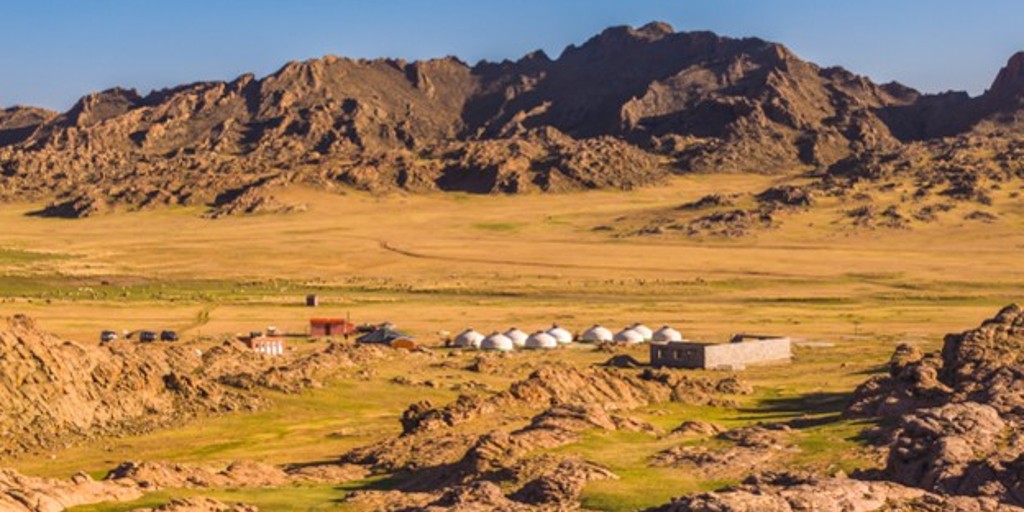
In Baga Gazriin Chuluu, you can explore various notable spots such as the Sudut Pass, which
features a charming aspen forest, and the Jargalant Cave, an 18-meter long cave that partially
requires crawling to navigate. Additionally, the Eye Spring at Nudnii Spring is known for its
healing mineral waters, ideal for washing and soothing eye sores.
For hiking enthusiasts, Takhilga Canyon offers a stunning view from its peak at 1768 meters and
is also home to wildlife like the Argali sheep and Siberian ibex. Another fascinating site is the
Ger Rock, which displays ancient rock paintings from the late Bronze Age, depicting a man and
two Siberian ibex connected by a hemp rope.
This region’s remote beauty and and historical attractions make it a significant stop on your road
trip to the Gobi Desert (Find all Infos about our 15 Day Journey here).
Masushir Monastery – Hidden Monastic Gem
Manzushir Monastery was originally established in the 18th century. It was once a major
religious center with 20 temples and a community of over 300 monks. Today, it showcases ruins
that include the main temple rebuilt into a museum displaying religious artefacts and vibrant
hand-painted details.
The area offers plenty of activities. You can hike along trails dotted with wildflowers, explore
ancient Buddhist cave paintings and reliefs on the cliffs, or simply enjoy the serenity of the
surrounding protected natural landscape
Terelj National Park – Adventure and Serenity
Terelj National Park offers a range of activities and attractions that make it a must-visit
destination during your Gobi Desert rad trip. Besides rock climbing, horse racing, and visiting
the iconic Turtle Rock, you can enhance your experience by exploring the Aryabal Monastery,
which provides a stunning vantage point over the park. Another must-see is the Chenggis Khan
Statue Complex located on the way to the park. This impressive 130 ft tall statue
commemorates the famous historical figure and offers panoramic views from its top.

For accommodations, there’s a variety of options that cater to different tastes and budgets. The
Apache Eco Camp is known for its comfortable Gers with heated floors, offering a cozy stay,
especially during the colder months, and features stunning valley views.
Glory Resort Mongolia provides a luxurious experience with its unique Hunnu-style yurts and
modern amenities, ideal for those looking for a bit more comfort and relaxation. Alternatively, the
Farmhouse Retreat offers a tranquil atmosphere with its garden oasis and fresh, locally sourced
meals, making it perfect for a peaceful retreat.
Back to Ulaanbaatar
As your off roading trip to the Gobi Desert and back concludes, returning to Ulaanbaatar offers a
moment to reflect on the journey’s incredible experiences.
Before departing, take advantage of the vibrant markets of downtown Ulaanbaatar for
last-minute shopping. The State Department Store or Naran Tuul Market are prime spots to find
souvenirs, from cashmere sweaters to traditional handicrafts.
This is also an excellent time to immerse yourself in local culture, perhaps catching a
performance at the National Academic Theatre of Opera and Ballet or visiting the Zanabazar
Museum of Fine Arts for a dose of Mongolian art.
Frequently Asked Questions
Is Mongolia friendly to tourists?
Yes, Mongolia is known for being very friendly and welcoming to tourists. The local population is
generally warm-hearted and eager to share their culture and traditions with visitors, making it a
pleasant destination for travelers. For female travelers coming to experience Mongolia, the
Mongolian authorities ensure that everyone’s trip goes smoothly. It’s advised to secure travel
insurance that covers medical emergencies is recommended when planning your trip to
Mongolia.
Is it easy to travel in Mongolia?
Traveling in Mongolia can be challenging due to its vast landscapes and underdeveloped
infrastructure, especially in rural Mongolia. The roads can be rough, and long distances
between destinations require good planning and time. For more efficient travel, consider
booking navigation assistane or a self drive travel package from SIXT. Travel insurance is
essential, especially one that covers medical evacuation.
Why is Mongolia so famous?
Mongolia is famous for its rich history with figures like Chinggis Khaan, vast open landscapes
like the Gobi Desert, and a unique nomadic culture that continues to thrive. Visitors often look
forward to trying traditional foods, such as fermented horse milk, and experiencing the
hospitality of a nomadic family. The country’s significant events, like the Naadam Festival, also
attract many travelers looking to experience Mongolia’s vibrant culture.
What to know before visiting Mongolia?
Before you visit Mongolia as a foreign national, it’s crucial to be prepared for its extreme
temperatures and rural conditions. Understanding local customs and etiquette is vital; for
instance, accepting offers of food and drink is a sign of respect. Medical equipment in remote
areas can be limited, so ensure that your travel insurance covers it comprehensively.
Is it easy to travel around Mongolia?
Navigating Mongolia can be difficult due to the sparse population and large distances between
places. While Ulaanbaatar is well-connected, traveling in rural areas often involves rough roads
and limited public transportation options.
Is Ulaanbaatar worth visiting?
Ulaanbaatar is definitely worth visiting as it offers a mix of modern and traditional experiences.
It’s the cultural, economic, and political heart of Mongolia, featuring museums, monasteries, and
markets filled with local people that showcase the country’s history and heritage. Foreign
nationals usually land in the capital at Chinggis Khaan International Airport. The city also serves
as a gateway to exploring the rest of the country, including national parks and the Gobi Desert.
When visiting, be prepared for air pollution and cold nights, and remember that most
establishments do not accept credit cards, so carry cash.